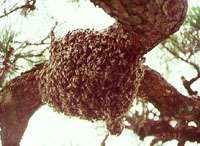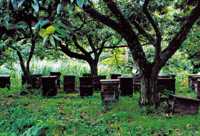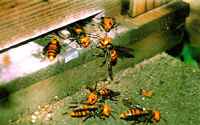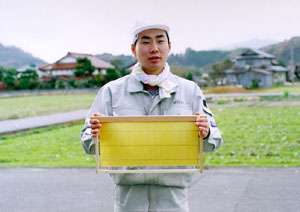1.
Springtime Management: Preventing Swarms
The hive becomes full around May to June as queen bees continue
to hatch from eggs laid during the spring, and the worker bees
work hard to bring nectar and pollen into the hive. When the space
for the brood and honey storage is about to disappear, "swarming" occurs. This is when a new queen bee is about to be born and the
old queen flies away all at once, along with close to half the
colony of worker bees, taking as much honey into their bodies
as possible for food. |

|
|

 Careful
checking Careful
checking
During this period of rapid expansion of the colony, the inside
of the hive must be checked once a week, and the queen cells
from which queen bees hatch must be removed. Basically, swarming
will not occur when the queen bee is new and there are many
frames, so maintaining this kind of environment makes the hive
easier to manage.
|
2.
Summertime Management: Protecting from the Heat
The enemy of the bees in the summertime is the heat. |

|
|

 Keep
hives out of direct sunlight Keep
hives out of direct sunlight
Putting the hives under trees in the shade or under a roof
will keep the temperature inside from rising.
|
3. Autumn Management:
Protecting the Honeybees from Wasps
|
|
Japanese
wasps appear after the middle of August. The wasp is the natural
enemy of the bee. The types most often seen at the bee farm
are Vespa mandarinia, Vespa analis insularis and Vespa simillima
Smith. The Vespa simillima Smith only catch honeybees one
at a time, roll them into a ball, and then carry them away,
but the Vespa mandarinia attack and crush honeybees one after
another with their mandibles until all the honeybees are wiped
out, then carry away all of the larvae. In the autumn, measures
are needed to protect the honeybees from these natural enemies. |

|
|
 Attaching a Wasp Trap
Attaching a Wasp Trap
We attach a wasp trap to the front of the hive entrance.
Shaped like a box, it takes advantage of the wasp's behavior
pattern of flying up and outward. The trap is designed so
that once the scout wasp gets inside it cannot get out again.
When one is caught, it gives off pheromones that attract
other wasps, which then become trapped one after another.
By using this device, damage can be significantly reduced,
even a patrol frequency of only once a weekly.
|
 |
 Preventive
Measures from the Springtime Preventive
Measures from the Springtime
Put some honey in a plastic bottle and thin it with water.
Add about a teaspoon of dry yeast to ferment the mixture.
Spread this around the hive before the spring is over so that
when the wasp's queen bee that has survived the winter comes
looking for sugar it is lured by the smell of fermentation
and drowns in the plastic bottle. When used during the spring,
this method aims to reduce the number of hornets in the vicinity.
(It is also possible to use a mixture of sake, vinegar, and
sugar.) |
4.
Wintertime Management: Preparing for the Winter
The job of the beekeeper in the winter
is to allow the honeybees to rest quietly until the spring.
Care must be taken so that the bees are not exposed to cold
and have enough food to last until the spring. When winter
comes, you cannot touch the hives even if you want to, so
it is important to prepare ahead of time. Preparation for
the winter begins when the first frost appears in autumn. |

|
|

 Winter
Preparation to be done in the Autumn Winter
Preparation to be done in the Autumn
To ensure that enough honey can be
stored up for the winter, no honey is extracted after
the middle of August. The number of frames is reduced,
which raises the density of honeybees within the hives
to create a heat-efficient environment.
|
 Protecting
from the Cold Protecting
from the Cold
The entrance to the hive is made smaller
to prevent cold air from getting inside. We also cover the
hives with a heat retention sheet for the winter. Honeybees
are active in temperatures of 8°C or warmer. We try
to avoid opening the hive on cold days to check inside because
doing so will cause the temperature to drop in the hive
and possibly harm the bees. |

|
 Checking
for Food Checking
for Food
We check to make sure that there is enough
food. If not, we add some sugar syrup. |
 Maintaining
the Hive and Frames Maintaining
the Hive and Frames
We use a burner to sterilize the empty hives with heat,
and remove the propolis stuck on the lid and in the cracks
of the hive, as well as the unneeded cells stuck to the
frames. We also repair any equipment that needs fixing. |
 |
 Building
New Hives Building
New Hives
This is the season for assembling new frames and painting
the hives. |
|









